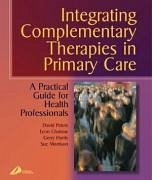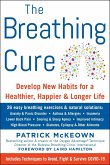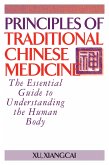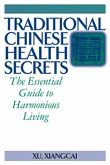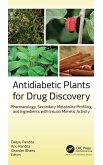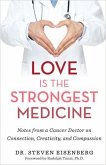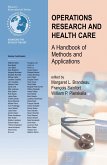David Peters, Leon Chaitow, Gerry Harris, Sue Morrison
Integrating Complementary Therapies in Primary Care
A Practical Guide for Healthcare Professionals
David Peters, Leon Chaitow, Gerry Harris, Sue Morrison
Integrating Complementary Therapies in Primary Care
A Practical Guide for Healthcare Professionals
- Broschiertes Buch
- Merkliste
- Auf die Merkliste
- Bewerten Bewerten
- Teilen
- Produkt teilen
- Produkterinnerung
- Produkterinnerung
This book is a practical and readable guide to the integration of complementary therapies into mainstream primary care. Based on the successful experiences of the authors in a clinical setting, it offers clinicians, therapists, and other healthcare professionals a realistic routemap of the key issues, as well as practical ways in which to ensure close working, appropriate referrals, advice and treatment decisions. Patient information sheets and clinical guidance sheets for key conditions are included in full.
Andere Kunden interessierten sich auch für
![The Breathing Cure The Breathing Cure]() Patrick McKeownThe Breathing Cure24,99 €
Patrick McKeownThe Breathing Cure24,99 €![Principles of Traditional Chinese Medicine Principles of Traditional Chinese Medicine]() Xu XiangcaiPrinciples of Traditional Chinese Medicine27,99 €
Xu XiangcaiPrinciples of Traditional Chinese Medicine27,99 €![The Chronic Diseases: Their Specific Nature and Homoeopathic Treatment The Chronic Diseases: Their Specific Nature and Homoeopathic Treatment]() Samuel HahnemannThe Chronic Diseases: Their Specific Nature and Homoeopathic Treatment42,99 €
Samuel HahnemannThe Chronic Diseases: Their Specific Nature and Homoeopathic Treatment42,99 €![Traditional Chinese Health Secrets Traditional Chinese Health Secrets]() Xu XiangcaiTraditional Chinese Health Secrets29,99 €
Xu XiangcaiTraditional Chinese Health Secrets29,99 €![Antidiabetic Plants for Drug Discovery Antidiabetic Plants for Drug Discovery]() Antidiabetic Plants for Drug Discovery198,99 €
Antidiabetic Plants for Drug Discovery198,99 €![Love Is the Strongest Medicine Love Is the Strongest Medicine]() Steven EisenbergLove Is the Strongest Medicine18,99 €
Steven EisenbergLove Is the Strongest Medicine18,99 €![Operations Research and Health Care Operations Research and Health Care]() Margaret L. Brandeau / Francois Sainfort / William P. Pierskalla (eds.)Operations Research and Health Care240,99 €
Margaret L. Brandeau / Francois Sainfort / William P. Pierskalla (eds.)Operations Research and Health Care240,99 €-
-
-
This book is a practical and readable guide to the integration of complementary therapies into mainstream primary care. Based on the successful experiences of the authors in a clinical setting, it offers clinicians, therapists, and other healthcare professionals a realistic routemap of the key issues, as well as practical ways in which to ensure close working, appropriate referrals, advice and treatment decisions. Patient information sheets and clinical guidance sheets for key conditions are included in full.
Hinweis: Dieser Artikel kann nur an eine deutsche Lieferadresse ausgeliefert werden.
Hinweis: Dieser Artikel kann nur an eine deutsche Lieferadresse ausgeliefert werden.
Produktdetails
- Produktdetails
- Verlag: Elsevier Health Sciences
- Seitenzahl: 352
- Erscheinungstermin: 13. Dezember 2001
- Englisch
- Abmessung: 275mm x 241mm x 22mm
- Gewicht: 1116g
- ISBN-13: 9780443063459
- ISBN-10: 0443063451
- Artikelnr.: 20951472
- Herstellerkennzeichnung
- Libri GmbH
- Europaallee 1
- 36244 Bad Hersfeld
- gpsr@libri.de
- Verlag: Elsevier Health Sciences
- Seitenzahl: 352
- Erscheinungstermin: 13. Dezember 2001
- Englisch
- Abmessung: 275mm x 241mm x 22mm
- Gewicht: 1116g
- ISBN-13: 9780443063459
- ISBN-10: 0443063451
- Artikelnr.: 20951472
- Herstellerkennzeichnung
- Libri GmbH
- Europaallee 1
- 36244 Bad Hersfeld
- gpsr@libri.de
PART ONE: BACKGROUND. 1. Complementary Medicine in Practice. Introduction.
What is CAM? The present situation. Provision of CAM in mainstream medical
care. Key issue to be addressed. How can CTs be integrated into primary
care? Summary. 2. Models and research in CTs. Introduction. Models and
theories of healing. Research. Research into specific conditions. Models
and research in individual therapies. Research evidence. PART TWO: CT
SERVICE IMPLEMENTATION. 3. Designing an integrated service. Introduction.
Key issues and questions for practice development and clinical governance.
Models of integration and delivery. People issues. Funding and resource
issues. Legal considerations. Issues of learning and communication.
Information for doctors on specific CT techniques, training & organization.
Practitioner development. Practice professional development planning.
Patient involvement. Design of material. An examples of service design: the
Marylebone Health Centre (MHC) project. Key information sources. 4.
Delivering and evaluating the service. Introduction. The service delivery
process. Examples of integrated delivery in practice. Can complementary
medicine be cost effective? New developments in the Marylebone PCG:
disseminating the approach. Summary. 5. Reflecting on and adapting the
service. Introduction. Feedback on the service. Reflections. Looking
forward. Summary: some final pointers. PART THREE: SERVICE DOCUMENTATION
AND INFORMATION SHEETS. 6. Information sheets on management of common
disorders. Allergies and intolerance. Anxiety and panic attacks. Asthma.
Cardiovascular disease. Headache and migraine. Infections. Irritable bowel
syndrome. Mechanical back, neck and head pain. Osteoarthritis. Painful
periods. Persistently aching joints and muscles. Premenstrual syndrome.
Problems around the menopause. Rheumatoid arthritis. Tiredness and fatigue.
7. Patient Advice and self-help sheets. Therapies. Conditions. Exercises.
Diets. 8. Blank forms and evaluation documentation. Introduction. GP to
in-house CT referral form. Therapy choice questionnaire. Analysing your
results. MYMOP guides and forms. The Smith Project - CP guide to clinical
data entry (filemaker Pro 4.1). Staff appraisal and development form.
Appendices. Appendix I: Summary and recommendations of a report by the
House of Lords Select Committee on complementary and alternative medicine,
November 2000. Appendix II: Useful addresses. Appendix III: Information
sources. Index.
What is CAM? The present situation. Provision of CAM in mainstream medical
care. Key issue to be addressed. How can CTs be integrated into primary
care? Summary. 2. Models and research in CTs. Introduction. Models and
theories of healing. Research. Research into specific conditions. Models
and research in individual therapies. Research evidence. PART TWO: CT
SERVICE IMPLEMENTATION. 3. Designing an integrated service. Introduction.
Key issues and questions for practice development and clinical governance.
Models of integration and delivery. People issues. Funding and resource
issues. Legal considerations. Issues of learning and communication.
Information for doctors on specific CT techniques, training & organization.
Practitioner development. Practice professional development planning.
Patient involvement. Design of material. An examples of service design: the
Marylebone Health Centre (MHC) project. Key information sources. 4.
Delivering and evaluating the service. Introduction. The service delivery
process. Examples of integrated delivery in practice. Can complementary
medicine be cost effective? New developments in the Marylebone PCG:
disseminating the approach. Summary. 5. Reflecting on and adapting the
service. Introduction. Feedback on the service. Reflections. Looking
forward. Summary: some final pointers. PART THREE: SERVICE DOCUMENTATION
AND INFORMATION SHEETS. 6. Information sheets on management of common
disorders. Allergies and intolerance. Anxiety and panic attacks. Asthma.
Cardiovascular disease. Headache and migraine. Infections. Irritable bowel
syndrome. Mechanical back, neck and head pain. Osteoarthritis. Painful
periods. Persistently aching joints and muscles. Premenstrual syndrome.
Problems around the menopause. Rheumatoid arthritis. Tiredness and fatigue.
7. Patient Advice and self-help sheets. Therapies. Conditions. Exercises.
Diets. 8. Blank forms and evaluation documentation. Introduction. GP to
in-house CT referral form. Therapy choice questionnaire. Analysing your
results. MYMOP guides and forms. The Smith Project - CP guide to clinical
data entry (filemaker Pro 4.1). Staff appraisal and development form.
Appendices. Appendix I: Summary and recommendations of a report by the
House of Lords Select Committee on complementary and alternative medicine,
November 2000. Appendix II: Useful addresses. Appendix III: Information
sources. Index.
PART ONE: BACKGROUND. 1. Complementary Medicine in Practice. Introduction.
What is CAM? The present situation. Provision of CAM in mainstream medical
care. Key issue to be addressed. How can CTs be integrated into primary
care? Summary. 2. Models and research in CTs. Introduction. Models and
theories of healing. Research. Research into specific conditions. Models
and research in individual therapies. Research evidence. PART TWO: CT
SERVICE IMPLEMENTATION. 3. Designing an integrated service. Introduction.
Key issues and questions for practice development and clinical governance.
Models of integration and delivery. People issues. Funding and resource
issues. Legal considerations. Issues of learning and communication.
Information for doctors on specific CT techniques, training & organization.
Practitioner development. Practice professional development planning.
Patient involvement. Design of material. An examples of service design: the
Marylebone Health Centre (MHC) project. Key information sources. 4.
Delivering and evaluating the service. Introduction. The service delivery
process. Examples of integrated delivery in practice. Can complementary
medicine be cost effective? New developments in the Marylebone PCG:
disseminating the approach. Summary. 5. Reflecting on and adapting the
service. Introduction. Feedback on the service. Reflections. Looking
forward. Summary: some final pointers. PART THREE: SERVICE DOCUMENTATION
AND INFORMATION SHEETS. 6. Information sheets on management of common
disorders. Allergies and intolerance. Anxiety and panic attacks. Asthma.
Cardiovascular disease. Headache and migraine. Infections. Irritable bowel
syndrome. Mechanical back, neck and head pain. Osteoarthritis. Painful
periods. Persistently aching joints and muscles. Premenstrual syndrome.
Problems around the menopause. Rheumatoid arthritis. Tiredness and fatigue.
7. Patient Advice and self-help sheets. Therapies. Conditions. Exercises.
Diets. 8. Blank forms and evaluation documentation. Introduction. GP to
in-house CT referral form. Therapy choice questionnaire. Analysing your
results. MYMOP guides and forms. The Smith Project - CP guide to clinical
data entry (filemaker Pro 4.1). Staff appraisal and development form.
Appendices. Appendix I: Summary and recommendations of a report by the
House of Lords Select Committee on complementary and alternative medicine,
November 2000. Appendix II: Useful addresses. Appendix III: Information
sources. Index.
What is CAM? The present situation. Provision of CAM in mainstream medical
care. Key issue to be addressed. How can CTs be integrated into primary
care? Summary. 2. Models and research in CTs. Introduction. Models and
theories of healing. Research. Research into specific conditions. Models
and research in individual therapies. Research evidence. PART TWO: CT
SERVICE IMPLEMENTATION. 3. Designing an integrated service. Introduction.
Key issues and questions for practice development and clinical governance.
Models of integration and delivery. People issues. Funding and resource
issues. Legal considerations. Issues of learning and communication.
Information for doctors on specific CT techniques, training & organization.
Practitioner development. Practice professional development planning.
Patient involvement. Design of material. An examples of service design: the
Marylebone Health Centre (MHC) project. Key information sources. 4.
Delivering and evaluating the service. Introduction. The service delivery
process. Examples of integrated delivery in practice. Can complementary
medicine be cost effective? New developments in the Marylebone PCG:
disseminating the approach. Summary. 5. Reflecting on and adapting the
service. Introduction. Feedback on the service. Reflections. Looking
forward. Summary: some final pointers. PART THREE: SERVICE DOCUMENTATION
AND INFORMATION SHEETS. 6. Information sheets on management of common
disorders. Allergies and intolerance. Anxiety and panic attacks. Asthma.
Cardiovascular disease. Headache and migraine. Infections. Irritable bowel
syndrome. Mechanical back, neck and head pain. Osteoarthritis. Painful
periods. Persistently aching joints and muscles. Premenstrual syndrome.
Problems around the menopause. Rheumatoid arthritis. Tiredness and fatigue.
7. Patient Advice and self-help sheets. Therapies. Conditions. Exercises.
Diets. 8. Blank forms and evaluation documentation. Introduction. GP to
in-house CT referral form. Therapy choice questionnaire. Analysing your
results. MYMOP guides and forms. The Smith Project - CP guide to clinical
data entry (filemaker Pro 4.1). Staff appraisal and development form.
Appendices. Appendix I: Summary and recommendations of a report by the
House of Lords Select Committee on complementary and alternative medicine,
November 2000. Appendix II: Useful addresses. Appendix III: Information
sources. Index.

